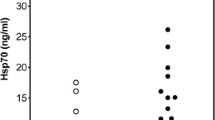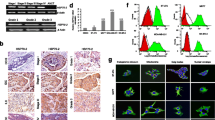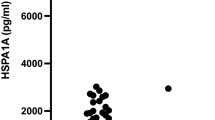Abstract
HspBP1 is a co-chaperone that binds to and regulates the chaperone Hsp70 (Hsp70 is used to refer to HSPA1A and HSPA1B). Hsp70 is known to be elevated in breast tumor tissue, therefore the purpose of these studies was to quantify the expression of HspBP1 in primary breast tumors and in serum of these patients with a follow-up analysis after 6 to 7 years. Levels of HspBP1, Hsp70, and anti-HspBP1 antibodies in sera of breast cancer patients and healthy individuals were measured by enzyme-linked immunosorbent assay. Expression of HspBP1 was quantified from biopsies of tumor and normal breast tissue by Western blot analysis. The data obtained were analyzed for association with tumor aggressiveness markers and with patient outcome. The levels of HspBP1 and Hsp70 were significantly higher in sera of patients compared to sera of healthy individuals. HspBP1 antibodies did not differ significantly between groups. HspBP1 levels were significantly higher in tumor (14.46 ng/μg protein, n = 51) compared to normal adjacent tissue (3.17 ng/μg protein, n = 41, p < 0.001). Expression of HspBP1 was significantly lower in patients with lymph node metastasis and positive for estrogen receptors. HspBP1 levels were also significantly lower in patients with a higher incidence of metastasis and death following a 6 to 7-year follow-up. The HspBP1/Hsp70 molar ratio was not associated with the prognostic markers analyzed. Our results indicate that low HspBP1 expression could be a candidate tumor aggressiveness marker.




Similar content being viewed by others
References
Asea A, Kraeft SK et al (2000) HSP70 stimulates cytokine production through a CD14-dependant pathway, demonstrating its dual role as a chaperone and cytokine. Nat Med 64:435–442
Calderwood SK, Theriault JR, Gong J (2005) Message in a bottle: role of the 70-kDa heat shock protein family in anti-tumor immunity. Eur J Immunol 35:2518–2527 doi:10.1002/eji.200535002
Ciocca DR, Clark GM, Tandon AK, Fuqua SA, Welch WJ, McGuire WL (1993) Heat shock protein hsp70 in patients with axillary lymph node-negative breast cancer: prognostic implications. J Natl Cancer Inst 85:570–574 doi:10.1093/jnci/85.7.570
Elledge RM, Clark GM, Fuqua SA, Yu YY, Allred DC (1994) p53 protein accumulation detected by five different antibodies: relationship to prognosis and heat shock protein 70 in breast cancer. Cancer Res 5414:3752–3757
Fisher B, Bauer M et al (1983) Relation of number of positive axillary nodes to the prognosis of patients with primary breast cancer. An NSABP update. Cancer 52:1551–1557 doi:10.1002/1097-0142(19831101)52:9<1551::AID-CNCR2820520902>3.0.CO;2-3
Fisher B, Redmond C, Fisher ER, Caplan R (1988) Relative worth of estrogen or progesterone receptor and pathologic characteristics of differentiation as indicators of prognosis in node negative breast cancer patients: findings from National Surgical Adjuvant Breast and Bowel Project Protocol B-06. J Clin Oncol 67:1076–1087
Gottwald E, Herschbach M, Lahni B, Miesfeld RL, Kunz S, Raynes DA, Guerriero V (2006) Expression of the cochaperone HspBP1 is not coordinately regulated with Hsp70 expression. Cell Biol Int 30:553–558 doi:10.1016/j.cellbi.2006.03.005
Hilsenbeck SG, Ravdin PM, de Moor CA, Chamness GC, Osborne CK, Clark GM (1998) Time-dependence of hazard ratios for prognostic factors in primary breast cancer. Breast Cancer Res Treat 52:227–237 doi:10.1023/A:1006133418245
Jaattela M (1999) Heat shock proteins as cellular lifeguards. Ann Med 31:261–271 doi:10.3109/07853899908995889
Jolly C, Morimoto RI (2000) Role of the heat shock response and molecular chaperones in oncogenesis and cell death. J Natl Cancer Inst 92:1564–1572 doi:10.1093/jnci/92.19.1564
Kabani M, McLellan C, Raynes DA, Guerriero V, Brodsky JL (2002) HspBP1, a homologue of the yeast Fes1 and Sls1 proteins, is an Hsc70 nucleotide exchange factor. FEBS Lett 531:339–342 doi:10.1016/S0014-5793(02)03570-6
Kaur J, Ralhan R (1995) Differential expression of 70-kDa heat shock-protein in human oral tumorigenesis. Int J Cancer 63:774–779 doi:10.1002/ijc.2910630604
McLellan CA, Raynes DA, Guerriero V (2003) HspBP1, an Hsp70 cochaperone, has two structural domains and is capable of altering the conformation of the Hsp70 ATPase domain. J Biol Chem 278:19017–19022 doi:10.1074/jbc.M301109200
Osborne CK (1998) Steroid hormone receptors in breast cancer management. Breast Cancer Res Treat 51:227–238 doi:10.1023/A:1006132427948
Papp D, Prohaszka Z, Kocsis J, Fust G, Banhegyi D, Raynes DA, Guerriero V (2005) Development of a sensitive assay for the measurement of antibodies against heat shock protein binding protein 1 (HspBP1): increased levels of anti-HspBP1 IgG are prevalent in HIV infected subjects. J Med Virol 76:464–469 doi:10.1002/jmv.20384
Payne SJ, Bowen RL, Jones JL, Wells CA (2008) Predictive markers in breast cancer—the present. Histopathology 521:82–90
Ralhan R, Kaur J (1995) Differential expression of Mr 70,000 heat shock protein in normal, premalignant, and malignant human uterine cervix. Clin Cancer Res 110:1217–1222
Ramp U, Mahotka C, Heikaus S, Shibata T, Grimm MO, Willers R, Gabbert HE (2007) Expression of heat shock protein 70 in renal cell carcinoma and its relation to tumor progression and prognosis. Histol Histopathol 2210:1099–1107
Raynes DA, Guerriero V Jr (1998) Inhibition of Hsp70 ATPase activity and protein renaturation by a novel Hsp70-binding protein. J Biol Chem 273:32883–328888 doi:10.1074/jbc.273.49.32883
Raynes DA, Graner MW, Bagatell R, McLellan C, Guerriero V (2003) Increased expression of the Hsp70 cochaperone HspBP1 in tumors. Tumour Biol 24:281–285 doi:10.1159/000076459
Raynes DA, Thomson CA, Stroster J, Newton T, Cuneo P, Guerriero V (2006) Human serum contains detectable levels of the Hsp70 cochaperone HspBP1 and antibodies bound to HspBP1. J Immunoassay Immunochem 27:251–264 doi:10.1080/15321810600734935
Shomura Y, Dragovic Z et al (2005) Regulation of Hsp70 function by HspBP1: structural analysis reveals an alternate mechanism for Hsp70 nucleotide exchange. Mol Cell 173:367–379
Suzuki K, Ito Y et al (2006) Serum heat shock protein 70 levels and lung cancer risk: a case-control study nested in a large cohort study. Cancer Epidemiol Biomarkers Prev 15:1733–1737 doi:10.1158/1055-9965.EPI-06-0005
Thanner F, Sutterlin MW et al (2003) Heat-shock protein 70 as a prognostic marker in node-negative breast cancer. Anticancer Res 232A:1057–1062
Thorpe SM, Christensen IJ, Rasmussen BB, Rose C (1993) Short recurrence-free survival associated with high oestrogen receptor levels in the natural history of postmenopausal, primary breast cancer. Eur J Cancer 29(A7):971–977
Torronteguy C, Frasson A, Zerwes F, Winnikov E, da Silva VD, Menoret A, Bonorino C (2006) Inducible heat shock protein 70 expression as a potential predictive marker of metastasis in breast tumors. Cell Stress Chaperones 11:34–43 doi:10.1379/CSC-159R.1
Vargas-Roig LM, Gago FE, Tello O, Aznar JC, Ciocca DR (1998) Heat shock protein expression and drug resistance in breast cancer patients treated with induction chemotherapy. Int J Cancer 79:468–475 doi:10.1002/(SICI)1097-0215(19981023)79:5<468::AID-IJC4>3.0.CO;2-Z
Volm M, Mattern J, Stammler G (1995) Up-regulation of heat shock protein 70 in adenocarcinomas of the lung in smokers. Anticancer Res 156B:2607–2609
Woodhouse EC, Chuaqui RF, Liotta LA (1997) General mechanisms of metastasis. Cancer 80(Suppl):1529–1537 doi:10.1002/(SICI)1097-0142(19971015)80:8+<1529::AID-CNCR2>3.0.CO;2-F
Acknowledgements
We wish to thank the patients that consented to participate in this study; Tiago Giuliane Lopes in the Pathology Department for the expert technical support with the histology studies; Dr. Moises Evandro Bauer for statistical support. Also, we wish to thank the financial support from FAPERGS, CNPq and the National Institute of General Medical Sciences (GM072628–02 (V.G.)).
Author information
Authors and Affiliations
Corresponding author
Additional information
This work was supported by FAPERGS, CNPq, and the National Institute of General Medical Sciences grant number GM072628-02 (V.G.)
The expression of HspBP1 (an Hsp70 co-chaperone) was analyzed in tumor samples and sera from breast cancer patients. HspBP1 is over expressed in these tumors and a seven year follow-up analysis found an association with a poor prognosis. Chaperones have been shown to play important roles in tumor biology and immunology; therefore, we believe the data in this study will serve as a basis for the formulation of a new hypothesis on chaperone-co-chaperone interactions and their role in tumor growth.
Rights and permissions
About this article
Cite this article
Souza, A.P., Albuquerque, C., Torronteguy, C. et al. HspBP1 levels are elevated in breast tumor tissue and inversely related to tumor aggressiveness. Cell Stress and Chaperones 14, 301–310 (2009). https://doi.org/10.1007/s12192-008-0085-6
Received:
Revised:
Accepted:
Published:
Issue Date:
DOI: https://doi.org/10.1007/s12192-008-0085-6




